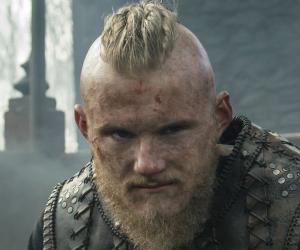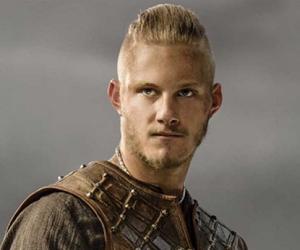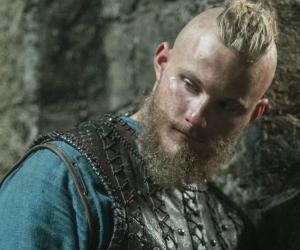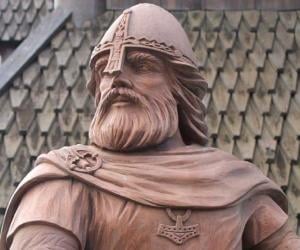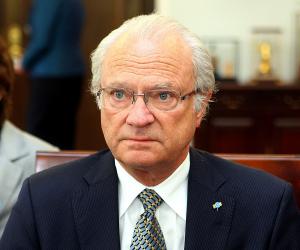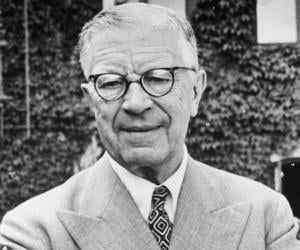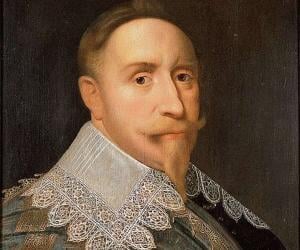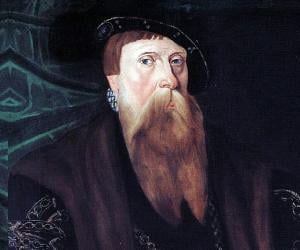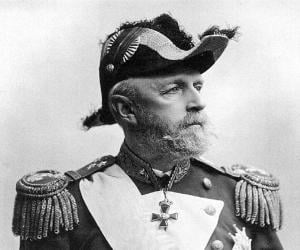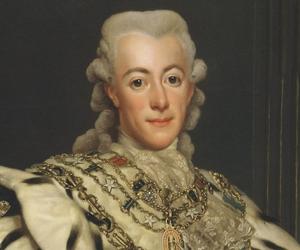Family & Early Life
Björn’s father, Ragnar Lothbrok, is a distinguished figure in the Viking Age Old Norse poetry and sagas. He conducted numerous raids into Francia and Anglo-Saxon England during the 9th century.
While there is no historical evidence that can prove beyond doubt that he actually existed, a significant amount of traditional literature has been dedicated to him.
According to the 13th century Icelandic legendary saga, the ‘Tale of Ragnar Lothbrok’, Ragnar’s father, Björn’s grandfather, was the Swedish king Sigurd Hring. The Hervarar Saga provides Björn’s immediate genealogy. His great-great-grandfather’s name was Valdar. After Valdar’s death, his son, Björn’s great-grandfather, Randver, ascended to the Swedish throne.
About the same time, Harald Wartooth established himself as the king of Denmark and embarked on a conquest. When Randver died, Sigurd Hring succeeded him, probably as a sub-subservient ruler to Harald.
Later, there was apparently a conflict between them, which culminated into the Battle of the Brávellir (Bråvalla) on the plains of Östergötland. Harald and several of his sons were slain and Sigurd established control on Sweden and Denmark.
After Sigurd’s death in about 804, Ragnar apparently became the king. In 845, the Siege of Paris, which was the culmination of a Viking invasion of France, took place. According to Frankish accounts, the leader of the Viking forces was a Norse chief named “Reginherus”, who is identified as Ragnar of the sagas by many scholars.
Ragnar had about 120 ships in his fleet that carried about 5,000 men. The Frankish emperor at the time was Charles the Bald, who attempted to defend his territories by assembling a smaller army.
Paris was eventually annexed but the Vikings left the city after they were paid a ransom of 7,000 French livres (2,570 kilograms (83,000 ozt)) of silver and gold by the Frankish emperor.
Ragnar married three times. His first wife was the shieldmaiden Lagertha, with whom he had one son, Fridleif, and two daughters, whose names are not known. His second wife was Thora Borgarhjört, the daughter of Herrauðr, who was either the king or earl of Götaland. Ragnar and Thora had two sons, Eiríkr and Agnar, before she passed away.
Ragnar’s third and final wife was Aslaug, the daughter of Sigurd, the slayer of the dragon Fafnir, and the shieldmaiden Brynhildr.
Aslaug is also a very important figure in the Norse traditional literature. Entranced by her beauty, Ragnar wanted to test her intelligence and ordered her to come to him neither dressed nor undressed, neither fasting nor eating, and neither alone nor in company.
She appeared before him wearing a net, biting an onion, and in the company of a dog. Ragnar could not help but admire her ingenuity and asked her to marry him. Initially, she declined, telling him that he had to complete his mission in Norway first.
They did eventually get married and she bore him five sons, including Björn. The others are Ivar the Boneless, Hvitserk, Rognvald, and Sigurd Snake-in-the-Eye. Among them, Ivar was probably the oldest.
Continue Reading Below
In Traditional Literature
‘The Tale of Ragnar’s Sons’ provides one version of Björn’s life. He and his brothers grew up to be equal to their father in ferocity and cunningness. They ventured far away from their home, raided new lands, and brought back huge quantities of plunder.
Soon enough, they were controlling a large territory that included Zealand, Reidgotaland (Jutland), Gotland, Öland and all the small islands. They then decided to make Lejre in Zealand their centre of power and appointed Ivar as their leader.
Ragnar became jealous of his sons’ achievements and appointed Eysteinn Beli as the king of Sweden with the instruction that he must prevent Björn and his siblings from conquering it.
During one summer, when Ragnar had left Scandinavia to campaign in the Baltic region, Björn’s half-brothers, Eiríkr and Agnar, arrived in Sweden by the lake Mälaren. They then demanded Eysteinn to declare himself as their vassal. They also told him that he had to give up his daughter Borghild, so she could become Eiríkr’s wife.
After consulting with Swedish chieftains, Eysteinn refused and led an attack against the brothers. Agnar was slain in the ensuing battle and Eiríkr was taken captive. However, Eysteinn sought peace and told Eiríkr that he was willing to let him marry Borghild and give him as much of Uppsala öd (the collection of royal estates that financed the Swedish monarchy) as he desired.
Eiríkr declined the offering, stating that, after such defeat, he wished to do nothing but choose the manner of his own death. Eysteinn granted the wish and Eiríkr was subsequently impaled on a spear that was planted on the battlefield, with his body raised about the dead.
Björn was playing tafl with Aslaug and Hvitserk when they heard the news of Eiríkr and Agnar’s passing. They subsequently raised a powerful army, invaded Sweden, and in a great battle, killed Eysteinn.
This further enraged their father and made him more envious of them. He thought that the only way for him to demonstrate that he was superior to his sons was to attack England with only two knarrs (merchant ships).
After he and his army landed in England, they experienced initial success. However, they were eventually defeated by Ælla, the king of Northumbria. Ragnar was captured and was thrown into a snake pit, where he perished.
Continue Reading Below
Björn and his siblings attacked England to avenge their father but Ælla defeated them in the first battle. Ivar refused to continue the campaign after realising that the English army was too big. Instead, he chose to make a truce with Ælla and settled in England.
Later, the brothers amassed a large army of their own, which the Anglo-Saxon sources called “The Great Heathen Army”. In the following battle, Ælla was captured and the blood eagle was performed on him.
Björn and his siblings then raided England, Wales, France, and Italy before returning to Scandinavia. They then divided their empire among themselves. Björn became the king of Sweden and Uppsala.
According to the ‘Hervarar saga’, he fathered two sons, Refil and Erik Björnsson. The latter would succeed him to the Swedish throne. The ‘Saga of Erik the Red’ claims that Björn had a son named Asleik (Aslak), who was the ancestor of Thorfinn Karlsefni, the famous Icelandic explorer.
Historical Accounts
History remembers Björn as a highly proficient chieftain and naval commander. His career as a raider reflects his admiration for his father. Accompanied by another legendary figure named Hastein, he embarked on several raids of France. According to some sources, Hastein was Ragnar’s friend and Björn’s mentor, while others claim that he was actually Ragnar’s son.
Björn wanted to accomplish something that would rival his father’s conquest of Paris. He had heard of Rome, unarguably the most prosperous and prominent city in Europe at the time, and decided to attack the city. In 859, he amassed a massive fleet of 62 ships and embarked on a journey towards the Mediterranean along with Hastein.
They plundered down the Iberian coast and raided several cities and settlements as they made their way through Gibraltar. They then attacked the south of France where they spent the winter. When the spring came, the fleet started sailing again. This time, they landed in Italy and looted the coastal city of Pisa.
Björn wanted his next conquest to be Rome but knew that the city would be well-guarded. He and Hastein concocted an ingenious plan to breach the city’s walls. In a message to the city’s bishop, Hastein lied about their condition. They wrote that they had not come to plunder; they had no strength left and were only seeking peace. They made the request to let them purchase what they required.
Furthermore, they also claimed their chief was ill and that he was dying. On his deathbed, he had converted to Christianity and wanted Christian sacraments and the burial on the consecrated ground within the church.
Continue Reading Below
The priests decided to allow a small group of Vikings into the city to accompany Hastein’s “body”. Some accounts state that these Vikings had swords under their robes. When they reached the church, Hastein got out of the coffin and led his men towards the city gate to let the rest of the Vikings in.
The city soon fell. However, the Vikings eventually realised that this was not Rome but Luna, an old city in Etruria, Italy. Furious and embarrassed, the Vikings plundered the city and set it on fire. After leaving Luna, they attacked Sicily and the coasts of North Africa. Some sources claim that they even made it to Alexandria, Egypt.
After plundering for three years, Björn’s men were ready to go home. During their return voyage, they fought the navy forces of Al-Andalus at the Straits of Gibraltar. The Muslim fleet had a weapon called “Greek fire” and the encounter proved to be catastrophic for the Vikings. They lost two ships and had previously lost 40 ships to a storm.
In order to restore morale among his men, Björn raided the Christian parts of Spain, including the city of Pamplona. While only 20 ships managed to get back to Scandinavia, Björn had accumulated a vast amount of wealth.
Facts About Björn Ironside
Björn Ironside was known for his exceptional skills as a warrior and strategist, earning him a reputation as a fearsome Viking leader.
He was said to have been the son of the legendary Viking Ragnar Lothbrok, and his exploits were chronicled in various sagas and historical accounts.
Björn Ironside was believed to have participated in raids across Europe, including in France, Italy, and Spain, showcasing his adventurous spirit and thirst for exploration.
According to some sources, Björn Ironside is said to have been the founder of the Swedish dynasty known as the Munsö dynasty, leaving a lasting legacy in Scandinavian history.
Despite his fierce reputation on the battlefield, Björn Ironside was also known for his intelligence and cunning, often outwitting his enemies with strategic maneuvers and tactics.
